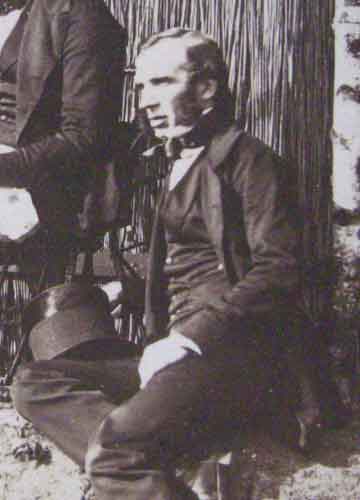1840 - 1860

Unidentified photographer
William Hunt
Albumen print, circa 1850
[Norfolk County Council Library and Information Service
A resident of Great Yarmouth1, William Howes Hunt, sometime linen draper2, was a watercolour artist of considerable local repute, an engraver and early photographer. After he retired from business he devoted himself entirely to art. His watercolours were striking, exhibited widely and dominated by marine subjects for which he had a passion.
His early paintings sold not only locally but also in London where they achieved good market prices.3 He engraved some views of Yarmouth and etched ‘after Rembrandt’. The British Museum has in its collection an etching he made from one of his drawings of St. Benet’s Abbey, on the banks of the River Bure, and it bears a pencilled note ‘Drawing in Collection of J.R.’. James Reeve was curator of the Norwich Castle Museum, where he’d worked for over 70 years, and he sold part of his collection to the British Museum.
That Hunt enjoyed a good reputation among his friends is evident, for he not only engraved his own work but other engravings of his work were made by Richard Girling. Of Hunt’s etchings Derek Clifford opined ‘These monochromes are of real quality, keenly felt, firmly and sensitively drawn, and have that typically Dutch air of pellucid calm.4’
A photograph album titled ‘Camera Sketches’ assembled by Thomas Damant Eaton, a retired Norwich silk mercer, contains many examples by Hunt, including a self-portrait5. Printed in 1845, these are the earliest authentically dated photographs in Norfolk public collections. These sepia, salted paper prints are made of silver in the fibres of the paper and have a soft, painterly appearance. They are optically fragile objects that were ‘state of the art’ in their day and were made from paper negatives. Despite fading, they provide insights into life at that time in a way that paintings rarely do.
Hunt’s photographic activity was recorded both by George Clayton Eaton, one of Thomas Damant’s sons, in a notebook6 and elsewhere published in Notes and Queries7 under the heading ‘Progress of Photography’.
First, George’s recollection is:
‘He was a clever man & one of the first photographers in this neighbourhood in the days when it was growing & only practiced by amateurs. Some of his earlier watercolours are very good but latterly they were of much less value. He made capital pen sketches at the heads of his letters. He corresponded with my Father & I have a book8 of these sketches cut off the letters. The subjects were not all original, & one or two were done from sketches of my own, to show how to treat them.’
Secondly, the editor in Notes and Queries writes,
‘As a further contribution to the History of Photography, we have been favoured with a copy of a letter from a well-known amateur, which details in a graphic manner his early photographic experiences.
“As there is a sort of reflux of the tide to Mr. Fox Talbot's plan, and different people have succeeded best in different ways, it may amuse you to hear how I used to work, with better luck than I have had since.
…
Mr. William Hunt, of Yarmouth, was my first friend and instructor in the art; and if there be any merit in the pictures I did before I knew you, the credit is due to him entirely.
…
P.S. - I now have the first picture I ever did, little, if at all, altered. It was done in July 1845, with a common meniscus lens. …‘
Given that almost half the photographs in ‘Camera Sketches’ are by William Hunt, sequentially dated from April to September, 1845, and the first by Eaton is dated ‘1845 July’, it seems highly probable that the “well-known amateur” referred to in Notes and Queries is, in fact, Thomas Damant Eaton. Although Hunt widely exhibited and successfully sold his paintings, he seems never to have shown his photographs publicly. When Eaton died in 1871, his son George wrote to William Hunt and in his reply9 Hunt wrote:
‘… I look back & well remember some very pleasant enjoyments in the pursuit of art when photography was in its infancy & numerous letters passed between us concerning it which probably contributed to our mutual improvement. Allow me to state I always held his opinions in the highest esteem & have to regret the loss of some more of my once numerous friends…’
Sources and Notes
- Blyth’s 1842 Directory lists Wm Hunt at Broad Row, Gt. Yarmouth.
The 1851 Census lists him as resident in the Market Place, Great Yarmouth
and employer of six hands. He died at 2 Marlborough Terrace, North Beach, Great Yarmouth. - Possibly the Hunt of ‘Miller & Hunt’ in the Market Place. Private correspondence.
- Obituary, Eastern Daily Press, 12 June, 1879.
- Clifford, Derek. Watercolours of the Norwich School. London: Cory, Adams & Mackay, 1965, p52.
- Camera Sketches, 1845. Eaton Collection, Norfolk Heritage Centre
- Norfolk Record Office, Eaton XII & XIII 4/2/71. G C Eaton Notebook 2, p27.
- Notes & Queries: A Medium of Inter-Communication for Literary Men, Artists, Antiquaries. Genealogists, etc.. London: George Bell. 1854. June 10, p549.
- Norfolk Record Office, ACC 1998/198. Thos. Damant Eaton 14th Feby. 1849.
- Norfolk Record Office, Eaton, 2/4/67 TCE.
